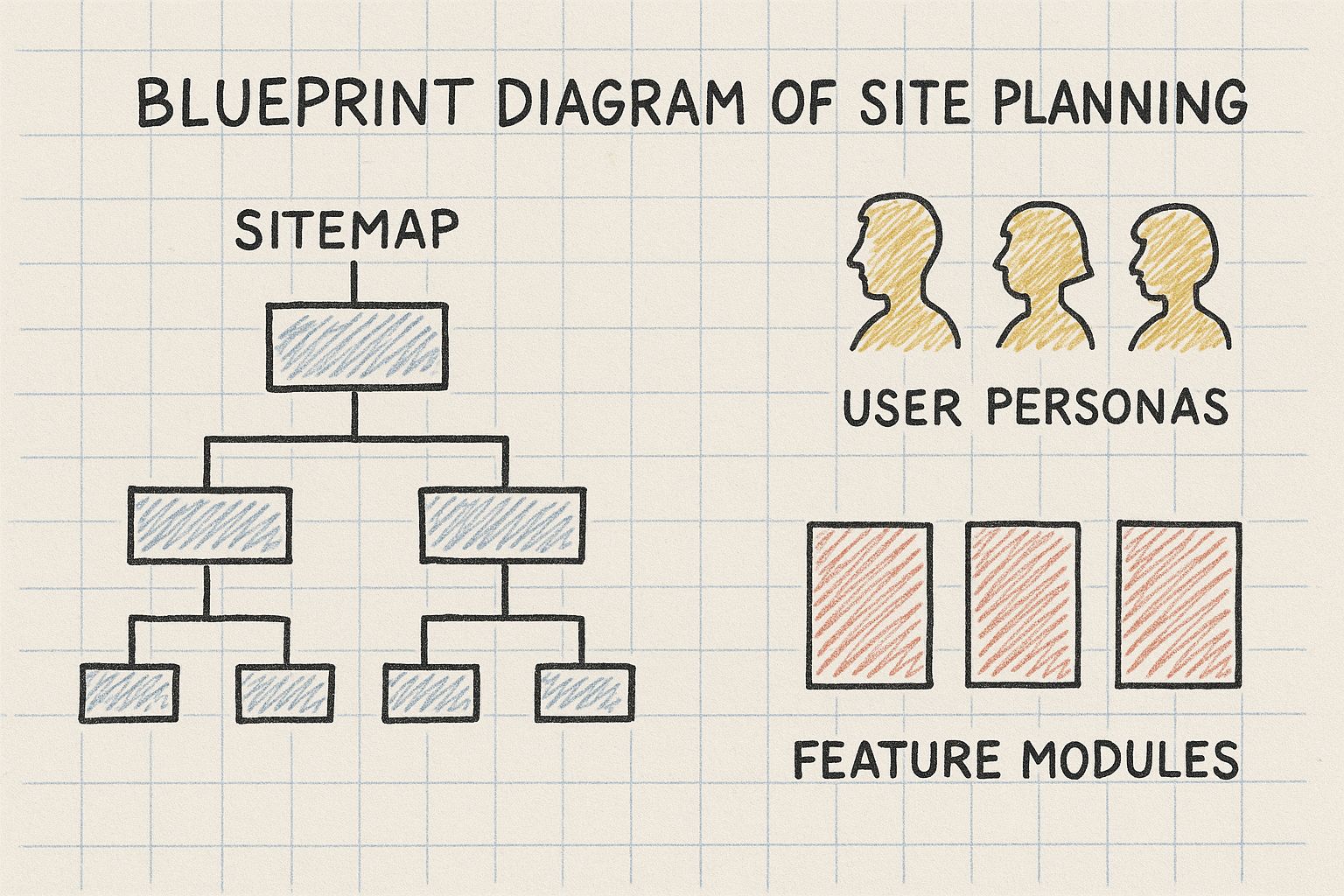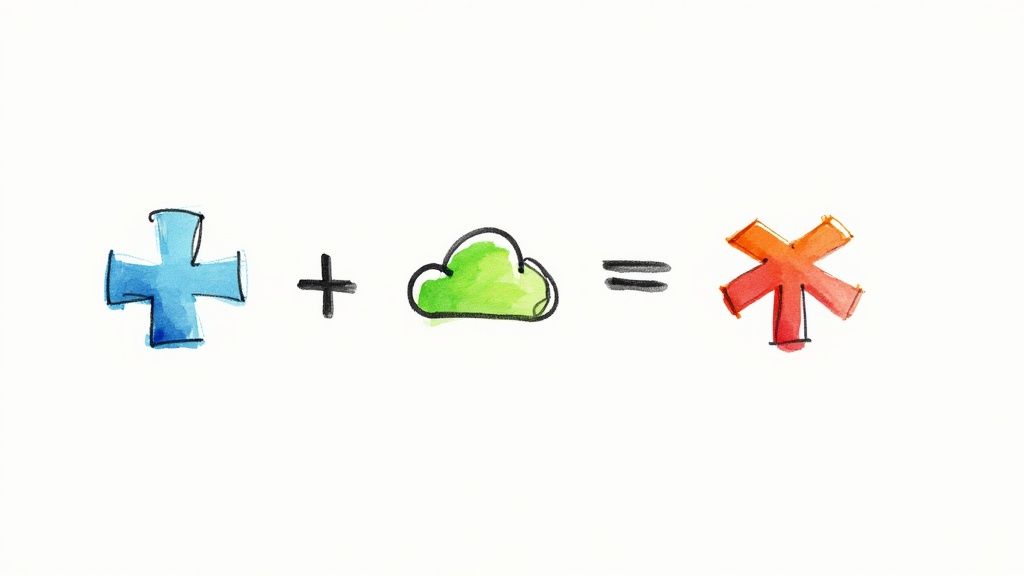September 28, 2025

Building a membership website is all about turning what you know into a thriving, profitable online community. The basic idea is simple: you offer exclusive, high-value content, and in return, members pay a recurring fee to get access. But it all starts with a solid plan—nailing down your niche, truly understanding your audience, and creating an offer that people can't wait to join. Get this right, and you're not just sharing your expertise; you're building a source of predictable income.
Before you even start looking at software or web design, you need a blueprint. This is the strategic foundation that separates the membership sites that take off from the ones that fizzle out. This is where you get crystal clear on your purpose, pinpoint your ideal member, and map out the exact value you’re going to deliver. If you skip this part, you're essentially just guessing.
The best membership communities spring from real passion. You need to pick a niche you could talk about for years, not just a few months. That genuine enthusiasm is what will keep you going, and it’s what will make your members stick around.
You have to get incredibly specific about who you're trying to help. Forget basic demographics; you need to dive into what makes them tick.
When you can answer these questions, you can build something people genuinely need. For example, instead of a generic site for "yoga teachers," you could zero in on "newly certified yoga teachers struggling to land their first studio clients." That kind of focus makes your value instantly obvious.
Let's be honest, one of the biggest draws of a membership site is generating stable, recurring income. The whole model is built on subscriptions, where members pay regularly for access. This isn't just a niche idea; by 2025, subscription models are expected to account for nearly 53% of all software revenue worldwide. That tells you just how powerful this approach is. You can dive deeper into the various https://groupos.com/blog/recurring-revenue-business-models to see which one resonates with your vision.
I see this all the time: creators offer way too much for way too little. You need to price your membership based on the transformation you provide, not just the amount of content you're giving away. When you price with confidence, you attract members who are serious about getting results.
A smart way to structure your pricing is with tiers. For instance, a basic tier might give people access to your content library. A premium tier, on the other hand, could add in live coaching calls or a private community forum. This lets you appeal to different budgets and commitment levels.
Getting this right technically is also crucial. A huge part of this is mastering WordPress user management so that each member automatically gets access to exactly what they paid for. This isn't just a "nice-to-have" skill; it’s fundamental for protecting your content and giving your members a smooth, professional experience.
Once you've got your plan nailed down, it’s time to pick your tools. This is where a lot of people get stuck, but it doesn't have to be complicated. The decision really just comes down to a classic trade-off: convenience versus control. What's right for you will depend on your budget, how comfortable you are with technology, and where you see your community going long-term.
You're essentially looking at two main roads. You can either go with an all-in-one platform or build a self-hosted site using something like WordPress. There's no wrong answer here, only what fits your specific situation.
Think of an all-in-one platform like GroupOS as renting a fully-furnished, all-inclusive apartment. Everything you need is already there—payment processing, member profiles, content hosting, and even community features are built-in and work together seamlessly. The biggest win here is speed and simplicity. You can get your site up and running fast without ever having to mess with plugins, security updates, or technical glitches.
Building a WordPress site with membership plugins is more like building a house from the ground up. It gives you total freedom. You control every single detail, from the layout and design to the specific features you want to offer. The catch? You're also the general contractor, responsible for all the construction and ongoing maintenance. This path definitely requires more time and a bit more technical confidence.
To make this clearer, let's break down the two approaches side-by-side.
Ultimately, this choice isn't just about the tech itself—it's about how you want to spend your time. Do you want to be all-in on creating content and building your community, or do you enjoy the hands-on process of building and refining your own digital space?
The planning phase helps bring these needs into focus, showing how all the pieces fit together.

Having a visual map like this makes it so much easier to distinguish your "must-have" features from the "nice-to-haves."
No matter which path you take, there are a few non-negotiable features every solid membership site needs. Before you commit to any platform, make sure it can handle these core functions without breaking a sweat.
If you're just starting out, an all-in-one solution is often the quickest way to get your idea out into the world. You can always check out a deep dive on what makes a great membership site platform to get more insight. The goal is to pick the technology that helps you move forward, not one that holds you back.
Your content is the lifeblood of your membership site. Let’s be real, it's the core promise you're making to your audience. When someone signs up, they aren't just buying access to a folder of files; they're investing in a solution, a transformation, or a shortcut to whatever goal they're chasing. Because of this, your content strategy can't be an afterthought. It needs to be deliberate, genuinely valuable, and built to keep people engaged month after month.
A classic mistake I see all the time is creators dumping a massive library of content on day one. It feels generous, right? But what it actually does is overwhelm new members. They get hit with analysis paralysis and don't know where to even start. It also kills the long-term value. What’s stopping someone from binging everything in a week and then canceling?
A much better, more sustainable way to think about this is blending foundational, "cornerstone" content with a steady drip of fresh updates. This approach respects your members' time and constantly reminds them why their subscription is worth it.
The most successful membership sites feel alive. They aren't just static libraries; they are dynamic, active communities where something new and exciting is always just around the corner. That sense of anticipation is an incredibly powerful retention tool.
One of the most powerful features at your disposal is content dripping. This simply means you release content to members on a set schedule. For instance, a new course module might unlock every seven days after they sign up. This creates a clear path, prevents that feeling of being overwhelmed, and dramatically increases how many people actually finish what they start.

You can even take this a step further by creating tailored content paths. If you want to deliver a truly personalized experience and control who sees what, it's worth learning about mastering conditional logic for dynamic websites. This advanced technique lets you show specific content based on a member's subscription tier, their stated interests, or the lessons they've already completed.
You don't need to reinvent the wheel for every single piece of content. Smart repurposing is your best friend for launching faster and delivering value in different formats.
Here’s what a smart repurposing workflow could look like:
This simple process multiplies the impact of a single effort. If you're looking for more ideas on how to get the most out of your work, there are plenty of proven strategies for https://groupos.com/blog/content-monetization that can help shape your approach. Ultimately, the goal is to build a content engine that works for you, ensuring your membership remains an indispensable resource for your community.
Great content will get people to sign up, but the experience is what makes them stay. I’ve seen countless membership sites with amazing courses fail because they overlooked this simple fact. A successful site isn't just a vault of information; it’s a place where members feel like they belong. The user experience you craft is the difference between a one-time customer and a raving fan who sticks around for years.
Think about it from the moment someone joins. A clunky or confusing onboarding process is the quickest path to buyer's remorse. You want to immediately make them feel smart for signing up. Design a welcome that’s smooth and reassuring—maybe a personal video from you, a simple "first steps" checklist, or a quick tour showing them where to find the good stuff right away.
Let's be honest: the community is often the real product. It's the glue that holds everything together long after a member has binged your initial content. You have to be deliberate about creating spaces where real connections can form. If you're new to this, it's worth taking a deep dive into how to build an online community from the ground up.

You don't need to overcomplicate things. Simple features can make a massive impact:
A huge mistake I see founders make is thinking a community will just magically appear. You have to be in there, especially at the start. Jump into discussions, celebrate people's wins, and make your members feel seen. Your energy sets the tone.
To really get people hooked, I’m a big fan of using gamification. This isn't about building a full-blown video game. It's about borrowing simple mechanics to encourage action and reward progress.
For example, you could award digital badges when a member finishes a course, hits a personal milestone, or becomes a top contributor in the forum. It sounds simple, but it works.
This strategy taps into our natural desire for accomplishment and recognition. As people earn these small rewards, they feel more invested in the community and their own journey. This is all part of a larger trend of creating micro-communities—intimate, engaging spaces that offer a real alternative to the noise of giant social media platforms. These little touches are what turn a basic membership into an experience people truly value.
A great launch is what separates a thriving community from one that never gets off the ground. It’s not about just flipping a switch and hoping for the best; it’s a carefully planned event designed to build real buzz and momentum. Honestly, the work you put in here can make all the difference between a trickle of sign-ups and a flood of new members on day one.
One of the smartest things you can do before you even open the doors is to start a waitlist. This isn't just about collecting email addresses. It's your first real test of market demand and your chance to build a relationship with your most eager potential members. Make it an easy "yes" for them by offering a solid incentive for signing up—maybe a free guide, an exclusive video, or a special launch-day discount.
As you get closer to launch, you can treat this waitlist group like VIPs. Share some behind-the-scenes content and sneak peeks to keep them engaged and excited for what's coming.
Instead of trying to go big right away, I often recommend starting with a "founding members" launch. Think of it as a soft opening. You're offering a limited-time, lower-priced deal to a small, initial group of people. The goal here isn't to get rich overnight; it's to build a core group of advocates who will help you shape the future of the community.
This strategy pays off in two huge ways:
The feedback you get from your first ten members is worth more than a survey of a thousand prospects. They are your co-creators. Listen closely, act on their suggestions, and you'll build a product that the wider market actually wants.
Once you’re officially live, your focus shifts from the launch sprint to the long-term marathon of sustainable growth. This is where your marketing really kicks in. Content is your best friend here—blog posts, videos, and social media updates should consistently point people toward your membership.
Email marketing is also non-negotiable. It’s how you’ll nurture people who are interested but not quite ready to commit, and how you can win back past members down the road. A simple, well-written email sequence can be incredibly effective at turning a curious visitor into a loyal member.
As your community grows, you have to keep an eye on the right numbers. New sign-ups are great, but they don't paint the full picture. The metrics that really define the health of your business are:
The wider membership market is an interesting place right now. While recent data shows about 45% of associations saw membership growth, 26% actually reported a decline. The good news? Member retention is still quite strong, with a median renewal rate of 84%.
What this tells us is that the game is changing. It's not just about getting new members anymore; it's about keeping the ones you have happy and engaged for the long haul. You can discover more insights about membership benchmarks to get a better handle on the trends shaping the industry.
Alright, let's tackle some of the big questions that always come up when you're planning a membership site. Getting these sorted out early on can save you a ton of headaches down the road.
This is the million-dollar question, isn't it? The honest answer is… it depends. The price tag really comes down to whether you go the DIY route or choose an all-in-one platform.
If you’re piecing it together yourself with a self-hosted WordPress site, your initial outlay might look smaller. You're looking at anywhere from $100 to $500 for things like hosting, a decent theme, and a membership plugin like MemberPress. But don't forget the hidden costs—your time is valuable, and if you run into a technical wall, hiring a developer can get expensive fast.
On the flip side, platforms like GroupOS bundle everything you need into one predictable monthly subscription. This can range from $50 to over $300 a month, usually depending on how many members you have and what features you need. No matter which path you take, always set aside a separate budget for actually creating your content and marketing the site. Those costs are a given.
Here’s the golden rule: your content has to solve a real, pressing problem for your members. People aren't just paying for information they could find on Google; they're paying you for a shortcut, a transformation, a clear path to a result.
The content that consistently gets people to stick around includes things like:
A killer strategy I've seen work time and time again is to mix your "evergreen" library of core content with a steady stream of fresh updates. A new member gets immediate value from the library, while long-term members stay engaged because there’s always something new. It’s the best of both worlds.
Keeping your members happy is the name of the game. If you want to reduce churn, you need to focus on two things: constantly delivering value and building a genuine community. This isn't something you worry about six months in; it starts the second someone signs up.
Your onboarding process is your first, best chance to make a great impression. Don't just send a "welcome" email. Guide new members directly to the good stuff—help them get a quick win so they immediately feel like they made a smart investment.
After that, it's all about keeping the momentum going. Drop new content regularly, be present in your own community forums, and actually listen to what your members are telling you. When people feel like they're part of something and that their voice matters, they'll have no reason to look for the exit.
Ready to stop wrestling with technology and finally build that community you've been dreaming of? GroupOS is an all-in-one platform designed to handle your members, content, and events so you can focus on what you love. Launch your membership site with confidence and start your free trial today.


